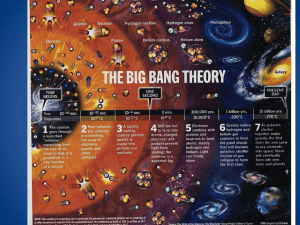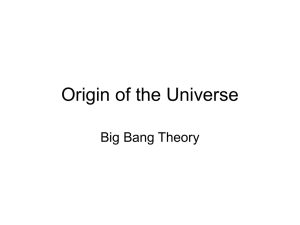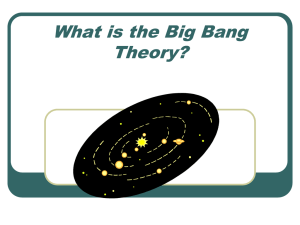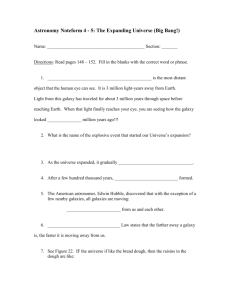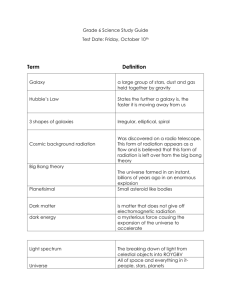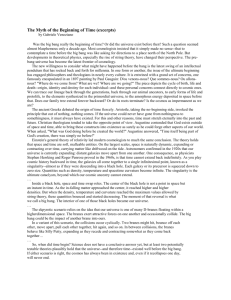Big Bang Balloon
advertisement
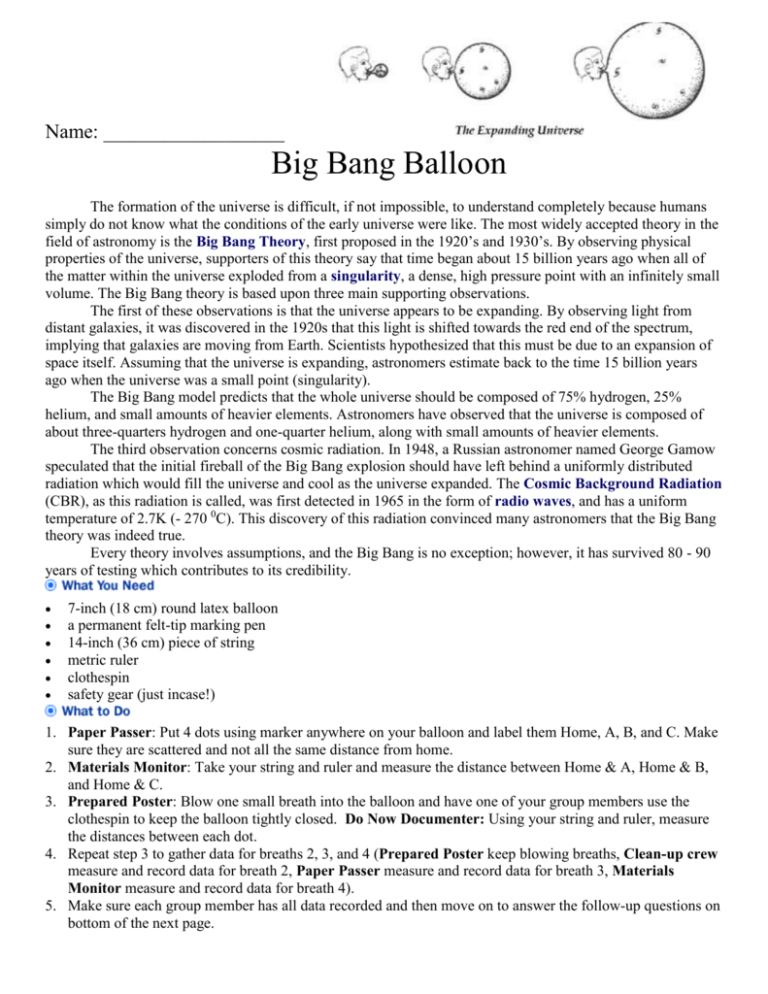
Name: __________________ Big Bang Balloon The formation of the universe is difficult, if not impossible, to understand completely because humans simply do not know what the conditions of the early universe were like. The most widely accepted theory in the field of astronomy is the Big Bang Theory, first proposed in the 1920’s and 1930’s. By observing physical properties of the universe, supporters of this theory say that time began about 15 billion years ago when all of the matter within the universe exploded from a singularity, a dense, high pressure point with an infinitely small volume. The Big Bang theory is based upon three main supporting observations. The first of these observations is that the universe appears to be expanding. By observing light from distant galaxies, it was discovered in the 1920s that this light is shifted towards the red end of the spectrum, implying that galaxies are moving from Earth. Scientists hypothesized that this must be due to an expansion of space itself. Assuming that the universe is expanding, astronomers estimate back to the time 15 billion years ago when the universe was a small point (singularity). The Big Bang model predicts that the whole universe should be composed of 75% hydrogen, 25% helium, and small amounts of heavier elements. Astronomers have observed that the universe is composed of about three-quarters hydrogen and one-quarter helium, along with small amounts of heavier elements. The third observation concerns cosmic radiation. In 1948, a Russian astronomer named George Gamow speculated that the initial fireball of the Big Bang explosion should have left behind a uniformly distributed radiation which would fill the universe and cool as the universe expanded. The Cosmic Background Radiation (CBR), as this radiation is called, was first detected in 1965 in the form of radio waves, and has a uniform temperature of 2.7K (- 270 0C). This discovery of this radiation convinced many astronomers that the Big Bang theory was indeed true. Every theory involves assumptions, and the Big Bang is no exception; however, it has survived 80 - 90 years of testing which contributes to its credibility. 7-inch (18 cm) round latex balloon a permanent felt-tip marking pen 14-inch (36 cm) piece of string metric ruler clothespin safety gear (just incase!) 1. Paper Passer: Put 4 dots using marker anywhere on your balloon and label them Home, A, B, and C. Make sure they are scattered and not all the same distance from home. 2. Materials Monitor: Take your string and ruler and measure the distance between Home & A, Home & B, and Home & C. 3. Prepared Poster: Blow one small breath into the balloon and have one of your group members use the clothespin to keep the balloon tightly closed. Do Now Documenter: Using your string and ruler, measure the distances between each dot. 4. Repeat step 3 to gather data for breaths 2, 3, and 4 (Prepared Poster keep blowing breaths, Clean-up crew measure and record data for breath 2, Paper Passer measure and record data for breath 3, Materials Monitor measure and record data for breath 4). 5. Make sure each group member has all data recorded and then move on to answer the follow-up questions on bottom of the next page. Name: __________________________ Record your measurements in the table below. State of Balloon Distance Home & A Distance Home & B Distance Home & C Deflated cm cm cm cm cm cm cm cm cm cm cm cm cm cm cm After 1st breath After 2nd breath After 3rd breath After 4th breath 1. How did the distance from the home dot to each of the other galaxies change each time you inflated the balloon? ___________________________________________________________________ ___________________________________________________________________ ___________________________________________________________________ 2. Did the galaxies (letters) near home or those farther away appear to move the greatest distance? ___________________________________________________________________ ___________________________________________________________________ ___________________________________________________________________ 3. How does this model explain the Big Bang Theory? ___________________________________________________________________ ___________________________________________________________________ ___________________________________________________________________ 4. Why might this model not be a perfect representation of the expanding universe? ___________________________________________________________________ ___________________________________________________________________ ___________________________________________________________________ 6. What possibly went wrong with your experiment? (What are your possible sources of error?) ___________________________________________________________________ ___________________________________________________________________ ___________________________________________________________________
